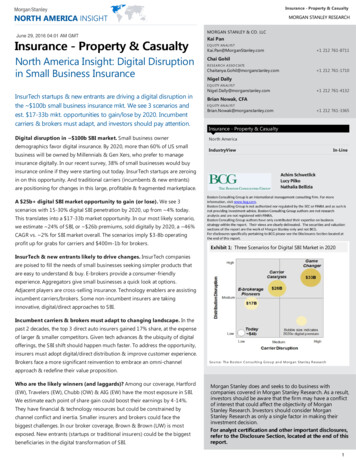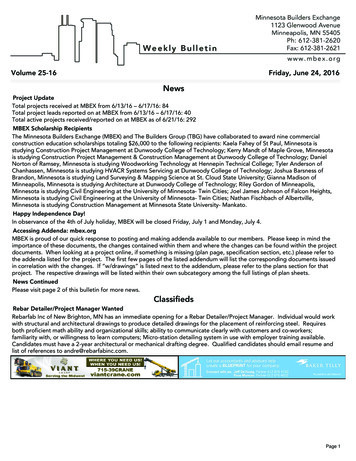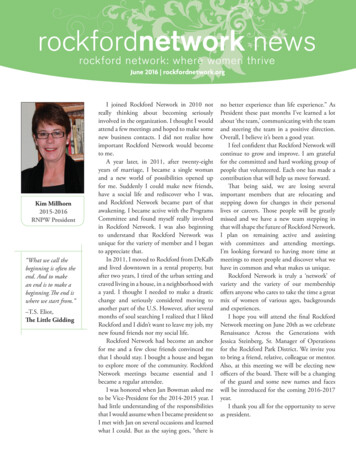
Transcription
Insurance - Property & CasualtyMONTHAM/PM GMTJune 29, DD,2016YYYY04:01HH:MMAM GMTInsurance - Property & CasualtyNorth America Insight: Digital Disruptionin Small Business InsuranceMORGAN STANLEY & CO. LLCKai PanEQ U ITY ANALYSTKai.Pan@MorganStanley.com 1 212 761-8711Chai GohilRESEARCH ASSO CIATEChaitanya.Gohil@morganstanley.com 1 212 761-1710Nigel DallyEQ U ITY ANALYSTNigel.Dally@morganstanley.comInsurTech startups & new entrants are driving a digital disruption inthe 100b small business insurance mkt. We see 3 scenarios andest. 17-33b mkt. opportunities to gain/lose by 2020. Incumbentcarriers & brokers must adapt, and investors should pay attention.Digital disruption in 100b SBI market. Small business ownerdemographics favor digital insurance. By 2020, more than 60% of US smallbusiness will be owned by Millennials & Gen Xers, who prefer to manageinsurance digitally. In our recent survey, 38% of small businesses would buyinsurance online if they were starting out today. InsurTech startups are zeroingin on this opportunity. And traditional carriers (incumbents & new entrants)are positioning for changes in this large, profitable & fragmented marketplace.A 25b digital SBI market opportunity to gain (or lose). We see 3scenarios with 15-30% digital SBI penetration by 2020, up from 4% today.This translates into a 17-33b market opportunity. In our most likely scenario,we estimate 24% of SBI, or 26b premiums, sold digitally by 2020, a 46%CAGR vs. 2% for SBI market overall. The scenarios imply 3-8b operatingprofit up for grabs for carriers and 400m-1b for brokers. 1 212 761-4132Brian Nowak, CFAEQ U ITY ANALYSTBrian.Nowak@morganstanley.com 1 212 761-3365Insurance - Property & CasualtyNorth AmericaIndustryViewIn-LineExhibit 1: Three Scenarios for Digital SBI Market in 2020InsurTech & new entrants likely to drive changes. InsurTech companiesare poised to fill the needs of small businesses seeking simpler products thatare easy to understand & buy. E-brokers provide a consumer-friendlyexperience. Aggregators give small businesses a quick look at options.Adjacent players are cross-selling insurance. Technology enablers are assistingincumbent carriers/brokers. Some non-incumbent insurers are takinginnovative, digital/direct approaches to SBI.Incumbent carriers & brokers must adapt to changing landscape. In thepast 2 decades, the top 3 direct auto insurers gained 17% share, at the expenseof larger & smaller competitors. Given tech advances & the ubiquity of digitalofferings, the SBI shift should happen much faster. To address the opportunity,insurers must adopt digital/direct distribution & improve customer experience.Brokers face a more significant reinvention to embrace an omni-channelapproach & redefine their value proposition.Who are the likely winners (and laggards)? Among our coverage, Hartford(EW), Travelers (EW), Chubb (OW) & AIG (EW) have the most exposure in SBI.We estimate each point of share gain could boost their earnings by 4-14%.They have financial & technology resources but could be constrained bychannel conflict and inertia. Smaller insurers and brokers could face thebiggest challenges. In our broker coverage, Brown & Brown (UW) is mostexposed. New entrants (startups or traditional insurers) could be the biggestbeneficiaries in the digital transformation of SBI.So u rce: Th e B o sto n Co n su ltin g G ro u p an d Mo rgan Stan ley ResearchMorgan Stanley does and seeks to do business withcompanies covered in Morgan Stanley Research. As a result,investors should be aware that the firm may have a conflictof interest that could affect the objectivity of MorganStanley Research. Investors should consider MorganStanley Research as only a single factor in making theirinvestment decision.For analyst certification and other important disclosures,refer to the Disclosure Section, located at the end of thisreport.1
Insurance - Property & CasualtyExecutive SummaryWe think the 100b small business insurance (SBI) market is in the early stages of a digitaldisruption. Changing demographics of small business owners, increasing number of InsurTech startups, andheightened focus of traditional carriers (both incumbents and new entrants) in this sizeable and profitablemarket are catalysts for this secular trend.Demographics favor digital insurance solutions. By 2020, more than 60% of small business in theUS will be owned by Millennials and Gen Xers, two groups that prefer to purchase and manageinsurance digitally. According to our recent survey, 38% of small businesses would buy insuranceonline if they were starting their businesses today.There are unmet insurance needs of small businesses. Proprietors look for simpler products,easier to understand and buy. "Mom and pop" agents have difficulty filling this demand ascommissions are too small and the investments too big.InsurTech startups are zeroing in on this emerging opportunity. Backed by venture capital andeven traditional insurers, a growing number of startups are focusing on SBI, leveraging experiencesfrom personal auto and other financial services, including FinTech companies.Traditional carriers are positioning for digital disruption. As SBI is a large ( 100b annualpremiums), profitable ( 90% combined ratio), and fragmented market (none of top players has morethan 5% share), large incumbents are ramping up their digital efforts and new entrants areexpanding into SBI.Changes in the personal auto insurance market provide an important case study. Over the past twodecades, the top three direct underwriters (GEICO, Progressive, and USAA) collectively gained 17% marketshare, at the expense of both larger and smaller competitors who are unable or unwilling to adapt the changingconsumer preference. Besides convenience, direct/digital distribution also lowers insurance costs which drivesconsumer adoption as well. We believe the pace of digital adoption in the SBI market could be much faster asthe internet and mobile technologies are ubiquitous now.A 25b digital SBI market opportunity to gain (or lose). We estimate 15-30% of SBI will be sold digitallyby 2020, up from 4% today. This translates into a 17-33b premium market opportunity.In the most likely scenario, we estimate 24% digital SBI penetration by 2020, or 26b annualpremiums. This represents a 46% CAGR vs. 2% for SBI market overall.Based on certain underwriting and operating margin assumptions, the digital SBI market could imply 3-8b operating earnings for underwriters and 400m-1b for brokers.Among our coverage, Hartford (EW), Travelers (EW), Chubb (OW), and AIG (EW) have the most SBIexposures (8-33% of total P&C premiums). We estimate one point market share gain could be 4-14%accretive to earnings while one point market share loss could negatively impact earnings by 2-7%.They have financial & technology resources but could be constrained by channel conflict and inertia.Smaller regional insurers could struggle to maintain their market share as SBI market consolidates, ifthey are not proactively adjusting their go-to market strategy.Smaller agents/brokers could face the biggest challenges. Among our brokerage coverage, Brown &Brown (UW) has the most SBI exposure.2
Insurance - Property & CasualtyLarger brokers AON (EW), Marsh McLennan (EW), Willis Towers Watson (OW), and AJ Gallagher(EW) among our coverage, while not immediately threatened by digital disruption in SBI, could faceincreasing competition if smaller brokers have to move up to middle markets.Digital disruption in SBI provides an opening for non-incumbents to gain a foothold — and share.The biggest beneficiaries could be InsurTech companies — nothing but to gain share. However thelack of data and underwriting expertise could impede or even doom some efforts.Exhibit 2: The SBI Market Is Poised for Strong Growth ( b)2015( 285b Total Commercial Lines Market)2020( 316b Total Commercial Lines Market)Non SBI, 185SBI, DigitallyUnderwritten, 4(4% of SBI)SBI, Notdigitallyunderwritten, 96Non SBI, 206SBI, DigitallyUnderwritten, 26(24% of SBI)SBI, Notdigitallyunderwritten, 84So u rce: SNL an d Mo rgan Stan ley Research estimatesExhibit 3: SBI Exposure ( m)So u rce: SNL an d Mo rgan Stan ley ResearchInsurTech and new entrants are likely to drive the disruption. InsurTech startups are focusing ondistribution: E-brokers (such as Embroker, Next Insurance, and CoverWallet) are providing consumer friendlydigital experience; Aggregators (like Compare.com and Einsurance) try to give small businesses a quick look attheir options; Adjacent players (such as Intuit, Justworks, and Zenefits) are cross-selling insurance;Technology enablers (like MarketScout and QuanTemplate) are assisting incumbent carriers or brokers.Traditional insurers are taking innovative, digital/direct approaches to SBI: Berkshire Hathaway plans to sellworker's comp and BOP policies directly online; Hiscox offers SBI products directly from its website; AmericanFamily invested in AssureStart, a direct writer of SBI; AIG, Hamilton Insurance Group, and Two Sigma plan toestablish a technology-driven platform in SBI. Most recently, Travelers announced a direct SBI online platform inthe UK. Incumbents must adapt to survive and thrive. Carriers need to adopt digital/direct distribution andreduce product complexity. Brokers must embrace omni-channel distribution and redefine their valueproposition.3
Insurance - Property & CasualtyWe outline three possible scenarios in the evolving SBI market for 2020. E-brokerage Pioneers scenario( 15% digital SBI, or 17b premiums) contemplates startup e-brokers appealing to newly created smallbusinesses. Carrier Catalysts scenario ( 24%, or 26b) assumes digital distribution platforms adopted bymajor incumbent carriers. Game Changer scenario ( 30%, or 33b) envisions a few dominant SBI carriersalso distribute directly online.Exhibit 4: Three Scenarios for Digital SBI Market in 2020So u rce: Th e B o sto n Co n su ltin g G ro u p an d Mo rgan Stan ley Research4
Insurance - Property & CasualtyThe (Digital) Future of Small Business InsuranceFrom music, photography, and video rental to travel agency, print media, and auto insurance, we have seenwaves of digital disruptions. We think small business insurance (SBI) could be the next frontier. How fast willthe digital breakthrough come? If US insurers are to increase their share of the attractive small businessmarket, they would do well to enhance their digital small business offering. There is every reason to believe thatsmall businesses will favor digital solutions for their insurance needs, and that a substantial advantage will go tocarriers and distributors that see what’s coming and get there first.Exhibit 5: Waves of digital disruption - SB Insurance is nextSo u rce: Th e B o sto n Co n su ltin g G ro u p an d Mo rgan Stan ley ResearchBecause of the tight regulatory environment in which it operates and the low frequency of customerinteractions, insurance has lagged other industries in terms of digitization. Disruptive players haven’t yetredrawn the landscape of insurance, thus giving customers a reason to alter their behavior or switch providers.So far, personal insurance is the only area where digitization has taken place in a meaningful way. Smallbusiness, however, won’t be far behind. The two types of insurance have a lot in common, and roughly two inevery five people who own a small business insurance policy look to get it from the same carrier they use forpersonal insurance.5
Insurance - Property & CasualtyExhibit 6: Digital SBI Market Is Poised for Strong Growth ( b)2015( 285b Total Commercial Lines Market)2020( 316b Total Commercial Lines Market)Non SBI, 185SBI, DigitallyUnderwritten, 4(4% of SBI)SBI, Notdigitallyunderwritten, 96Non SBI, 206SBI, DigitallyUnderwritten, 26(24% of SBI)SBI, Notdigitallyunderwritten, 84So u rce: SNL an d Mo rgan Stan ley Research estimatesWhat makes it highly likely that small business insurance offerings will take on a more digital character — anddo so, we think, more quickly than many in the industry expect — is the changing composition of customers inthe segment. By 2020, more than 60% of small businesses in the US will be owned by Millennials and Gen Xers— two groups that prefer to do as much as possible digitally. Small businesses come and go quickly, reflectingthe increase in the freelance economy and the ease with which many workers go back and forth between fulltime jobs and running their own single-person businesses or consultancies. These single-person businesses arepart of a surge in so-called “microbusinesses” (businesses with 0-4 employees), and are part of the reason why,according to estimates by the Boston Consulting Group (BCG), roughly one in every four small US businessesthat will exist a year from now don’t exist today. The variable workload and intermittent risk exposure of smallbusinesses (not just microbusinesses) is ideal for a type of insurance that is more flexible than traditionalinsurance. Digital solutions for purchasing and managing insurance products may be in the best position to fillthis segment’s needs.Exhibit 7: Steady Growth Ahead for US Small BusinessSo u rce: Th e B o sto n Co n su ltin g G ro u p an d Mo rgan Stan ley Research estimatesIt isn’t just those starting small businesses today and in the next few years who will create the demand for digitalinsurance solutions. Plenty of existing US small businesses would jump at the chance to use digital channels forpurchase and management of insurance if convenient options existed. These businesses already make extensiveuse of online and cloud technology for their business dealings. For instance, many use Intuit QuickBooks tohandle their taxes and financial reporting, Square to process mobile payments, and platforms like Zenefits tomanage their human resources needs.6
Insurance - Property & CasualtyThe interest in digital insurance solutions among existing small businesses came through clearly in an April2016 survey conducted by BCG (see Appendix I for details). Thirty-eight percent of existing small businessowners said if they were starting their businesses today, they would want to buy their insurance directly online.The percentage saying this was significantly higher (49%) among those running newly formed businesses —that is, businesses started in the last two years.The holdup: a lack of strong digital offerings. Indeed, the real obstacle to growth in the digital part of thesmall business insurance market isn’t the readiness of the customer base — it’s the absence of strong digitalproducts and propositions from suppliers. For the US small business insurance market to move toward moredigital solutions, carriers and distributors will have to take a new approach to the customer experience.Imperatives for carriers in an era of digitally distributed insurance.Reduce product complexity. Insurance continues to be a complicated product — full of legallanguage, multiple coverage tiers and exemptions, and cumbersome claims processes — making itconfusing and difficult to use. Put another way, traditional insurance products are very different fromwhat one encounters elsewhere in the digital realm, where convenience and instant gratification arethe norm. To underwrite more premiums digitally, small business insurance providers will have todevelop simpler modular products, ones written in plain English and easy to understand and buy.They are going to have to find ways to speed up the application process, with shorter forms that canbe prepopulated with existing data (such as small business’ financial statements or real estateinformation). Finally, the coverage schemes and pricing are going to have to become more flexible tobetter suit the needs of small business owners. This could involve usage-based or on-demandmodels that provide coverage only if and when needed.Improve customer service, particularly in claims. One of the big inconveniences of insurance is all themanual steps that are required when the policyholder is making a claim. This has started to change inpersonal insurance — people who have been in car accidents can often send pictures of theirdamaged vehicles using smartphones — and business insurance has to follow suit. Another part ofimproving customer service is ensuring that all claim-related transactions, such as appraisals,eyewitness statements and other supporting documents, are immediately available to all parties atthe same time. In much the same way that a customer can track a package delivery on hersmartphone in real time, she should be able to see every update while her insurance claim is inprogress. At the same time, the technology shouldn’t be overused; there are interactions that arebetter done person to person, such as when an injury has occurred.One good thing about becoming customer centric in this way is that it won’t necessarily be costlier tocarriers. In fact, by making the right digital investments, carriers will be able to automate moreprocesses, enable self-service where appropriate and redeploy their human resources moreproductively.Imperatives for distributors in an era of digital insurance. If anything, the distribution side of the businesswill have to undergo an even more dramatic reinvention than the carrier side if it is to remain relevant in an eraof digitally distributed insurance. Agents and brokers have to:Embrace an omni-channel approach. In today’s world customers interact with their brokers andcarriers through many different channels: call centers, the Internet, email, mobile technology, and inperson. Many customers prefer to go back and forth between channels, depending on the nature ofthe interaction or their personal situation. To these customers, a good experience would be one inwhich all of the channels were seamlessly integrated and had the same customer information at alltimes. In other words, if the customer made changes to a policy online through the carrier’s website,he would want his agent (when he spoke to the agent two days later) to be fully aware of the onlineinteraction and its outcome. This isn’t what happens currently. The status quo today is for agents totry to “own” all interactions with the customer. This leads to a bad customer experience (if thecustomer would rather change his address online and the agency doesn’t have that capability) and toa poor use of the agent’s time (since the agent has to receive the change and manually feed it7
Insurance - Property & Casualtythrough to the carrier). An omni-channel approach that gets past these limitations — allowingcustomers to use any channel in a seamless way — will improve the customer experience and agentproductivity.Redefine the value proposition of distribution. Brokers and agents have typically played their biggestroles in the acquisition and renewal stages. They need to provide value at other points that matter tocustomers — including risk prevention and claims handling. Another way to say this is thatdistributors (despite the business model of receiving commissions from carriers) need to act asthough they have a direct fiduciary responsibility to clients. If they are to improve the valueproposition to the customer, agents and brokers will have to heavily leverage technology. Whetherthey’ll be able to do this is a question. With many of their relationships not generating more than 150 to 250 in annual commissions, smaller brokers and agencies don’t have the scale to make theinvestment that’s required in digital.Develop new marketing capabilities for customer acquisition and retention. In the past, traditionalagents and brokers acquired broker-of-record status by sitting down with small businesses andpresenting their pitches (the proverbial kitchen table conversation). The new generation of smallbusiness owners (whether they are wine stores, six-person law firms, or physical therapy practices)will be most easily engaged online. Most brokers can’t afford t
Kai Pan EQUITY ANALYST 1 212 761-8711 Chai Gohil RESEARCH ASSOCIATE 1 212 761-1710 Nigel Dally EQUITY ANALYST 1 212 761-4132 Brian Nowak, CFA EQUITY ANALYST . Changes in the personal auto insurance market provide an important case study. Over the past two decades, the top th











